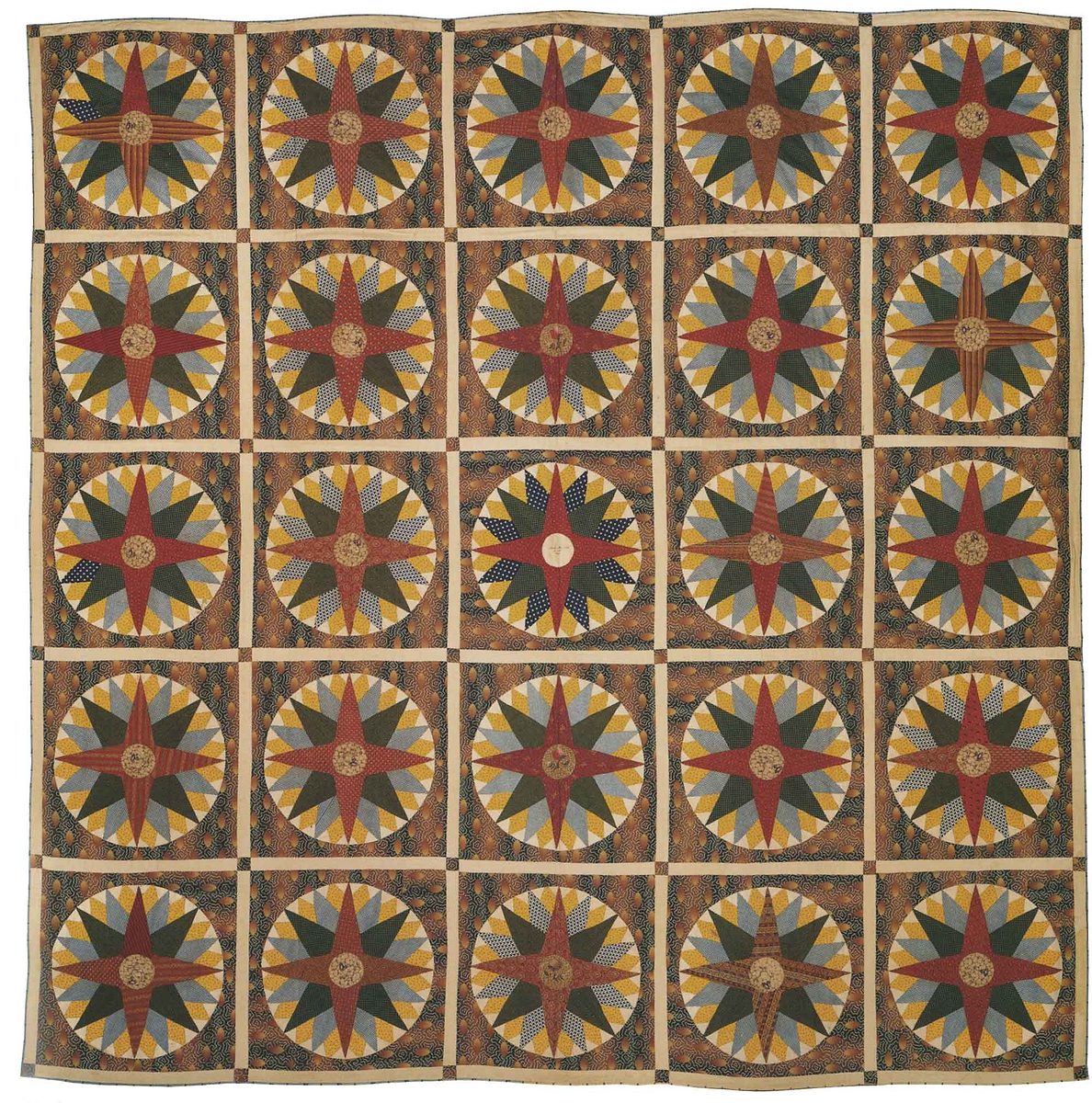Early American quilting is a form of art that has captured the attention of women for generations. To this day, it enjoys a growing and enthusiastic following, including among men, who represent about 1% of quilters in the U.S. and Canada today. To better understand the history of this beautiful art form, we interviewed several experts - keepers of an important artisanal trade - who graciously shared their knowledge for this article.
In the late 17th century, quilting became a form of showcasing women’s needlework. During this time, women in rural areas used homespun thread and fabrics - a time-consuming and costly process. Betsey Telford-Goodwin, owner of Rocky Mountain Quilts in York, Maine, and a historical quilt lecturer and appraiser said, “Families with means could afford to purchase raw materials and threads for quilting. Affluent women could purchase exquisite fabrics imported from France, England, and India, while rural families were mostly creating quilts from homespun fabrics. Creating a quilt in rural areas was often a two-year project - beginning with raising flax for linen and sheep for wool. Even the thread used in quilting was homespun.”

Star of Bethlehem quilt. Circa 1835.
While this handwoven process was complex, an added complication was the fact that England had a hold on America’s raw materials. The American textile industry had yet to emerge, so the fabrics were made solely from raw materials, with finer fabrics smuggled in through secret tunnels in Newburyport, Massachusetts. Betsey went on to explain that, “Prior to the Revolutionary War, England had rules and regulations in place and one such rule was specifying what type of sheep were allowed to be raised on American soil. Mutton sheep were allowed, which produce a coarse wool. This led to the creation of linsey-woolsey, a blend made from this mutton wool. Linsey-woolsey was strong but not soft. The finest, softest wool is from merino sheep, and early on these sheep were forbidden to be reared in America. Additionally, all wool sheared in America was shipped back to England, processed there, and then sold back to Americans under a system known as mercantilism.” It is plain to see why a revolution was brewing.
The advent of three inventions transformed both quilting and the textile industry. Manufacturing of textiles by power looms started in England in 1785, and the subsequent Industrial Revolution allowed Americans to buy less expensive commercially manufactured fabrics from England before the textile mills were set up in New England. In 1793, the cotton gin accelerated the process of separating the cotton seeds from the cotton fibers, and in 1813 the power loom was introduced to America. These innovations reduced the cost of fabric, allowed the art of quilt-making to morph from an exclusive activity to a more common one, and significantly shortened the time needed to complete a quilt. It also moved quilting from an individual task to a group task. Many hands were able to simultaneously quilt different sections of a single whole quilt (bedcovering) stretched out on a frame.

Quilting bee circa 1876
In rural areas, friends and family members gathered around the hearth at each other’s homes to quilt, conversing over current events and working on different sections concurrently. Quilts served practical purposes in American households as they were crafted into petticoats, bed coverings for warmth in the winters, and even added layers of protection during battle.
As more women gathered to quilt, it not only increased speed of completion but also provided a sense of comradery. In rural areas, groups of women quilted together in community gatherings, while affluent women often quilted at home with sisters, mothers, and other relatives. The creation of patterns evolved, showcasing women’s ingenuity and mathematical skills. Many times, women wanted to duplicate a pattern but change the colors, and having directions with measurements proved immensely helpful.

Quilted whole cloth dressing table cover from 1812
In early American times, proficiency with needle and thread was a basic skill, much like learning to read and write. As this ‘pattern’ proficiency became more technically advanced, stitching and appliqueing advanced as well. Over time, this skill morphed into sewing scenic patterns with the thread, such as flora, fauna, or even the illusion of movement using wave stitching. Mathematical precision is critical when quilters are working with complex designs and borders. It would be abysmal if a quilt was to be four sunbursts across and six sunbursts down, but when putting the quilt together, they were all misaligned. Over time, textile mills became abundant, and the selection of fabrics increased. This combined with advances in stitching techniques to allow quilts to tell a story through intricate needlework or using multiple fabrics.
“In the 18th century, the width of manufactured fabric was only 12 to 15 inches, selvage to selvage,” said Betsey Telford-Goodwin. “Women’s clothing was made from the entire width, and therefore there were no scraps of fabric. Most of the quilts created during the era were called whole cloth, resulting from numerous strips of the same fabric sewn together, creating one large piece of fabric. After the Revolutionary War, when women’s clothing styles changed, there were scraps left over from cutting fabric to create these patterns. And thus quilts created from a mixture of fabrics were born. Pinwheels, mariner’s compass, Baltimore Album quilts, and Star of Bethlehem were a few patterns that created art from fabric pieces. Complicated and quite interesting questions also arose and were solved in emerging quilting groups: which pattern became a foreground vs. background, how to introduce movement in a still object, and how to tell a chronological story through images.”

This Blue Resist is a rare and coveted pattern. Indigo blue will not fade in sunlight. Here you can see an example of the block that was used in the lost wax process to create unique patterns. A Blue Resist quilt in the home was a mark of affluence. 1700s.
Printed periodicals from the mid-19th century encouraged quilting through their ”ladies’ pages.” The first American newspapers and farmer’s journals, including the Boston News-Letter, the New York World, and The American Farmer were such publications offering a “ladies’ section.” Sara Schechner, a historian and award-winning quilter, notes, “In these sections quilting patterns emerged with details about various styles. These individual styles of quilting were quickly shared throughout the country, which provided an opportunity to cross pollinate patterns, colors, stitching techniques, and fabrics, and to answer quilting questions. The effect on the craft was exponential.” Correspondence by mail also provided a way to share patterns and solve math equations within quilting projects.

Less affluent and poor families reused fabric scraps whenever they could. This is an example of tree bark home spun woolen dyed backing and plaids. Everything is home woven and home dyed (with true indigo vegetable dye). The process to create a quilt – to raise wool or flax, spin, weave, dye, and sew – could be as much as two years. Circa 1825.
| Courtesy of Rocky Mountain QuiltsThe introduction of sewing machines in the 1850s allowed the basic stitching of quilts to be completed at a faster rate. The more decorative seam work, such as the precision required for hexagonal pieces (in popular patterns such as Grandmother’s Flower Garden) still needed to be handsewn, though, and are still made this way today.
Proficient sewing was always a mark of excellence for affluent women, and this did not change after the invention of the sewing machine. Rural women could not afford to purchase a sewing machine, therefore almost all quilts continued to be pieced and quilted by hand. While the early American quilts merged function and beauty, the quilts of today are masterful pieces of art. This evolution was showcased in 1971, when the Whitney Museum in New York held the first-ever exhibit of quilts. Sixty-one quilts were hung (an incredible number), and attendance was favorable, to say the least. The 1976 bicentennial led to a resurgence of interest in earlier times, resulting in the exponential growth of quilting circles and sewing bees, which are still strong in numbers today (including dozens in New England alone).

Artist Eileen Kahan uses multiple techniques to create her unique designs. Quilt by Eileen Kahan
Eileen Kahan, a member of Quilters’ Connection and Rising Star Quilters guild, said “Sewing and quilting have been a part of my being ever since I was a child. I relate to people through words and visuals—fabric and threads are part of my life.” Her intricate designs and coloring techniques are modern, and her art pieces are unique. In one quilt, for example, she used grasses from her garden and stamped images of the grasses on fabric using a gel plate with acrylic ink to provide a three-tone effect. She then matched the thread to accentuate the individual hand-colored fabrics. When completed, Kahan put white sashing between the 18 pieces to create a jagged bottom edge. The unique pattern brings a fresh look to the art of quilting. She uses geometric formation to alter the historic rectangular shape seen most frequently in quilting, creating asymmetric designs both in the arrangement of blocks and the shape of the final quilt.
It seems that the experience of the quilter, of making a quilt, provides one the opportunity to express creative mastery over design and skill with a needle. One of the wonders of quilting nowadays is the opportunity to simply begin with needle and thread and some fabric. Wonderful healings can come from these actions.
QUILTS 250: Stitching in the Spirit of Democracy
Celebrate the 250th anniversary of the battles of Lexington and Concord on April 19, 1775, with Quilts 250: Stitching in the Spirit of Democracy. This free show will be open to the public and will follow the development of quilting from the revolutionary period to the present, featuring 250 works by local quilters. Themes will include:
The Spirit of 1775 | Antique, Antique-Inspired, and Traditional Quilts | Quilts of Protest
Modern, Contemporary, and Pictorial Quilts | Student Quilts and Fiber Arts
Quilts 250 is sponsored by the Concord250 Celebrations Committee and organized by the Concord Piecemakers, Quilters’ Connection, and Rising Star quilt guilds. For more information and instructions on how to enter your quilts, please email quilts250@quiltersconnection.org.
March 22-23, 2025 • Concord Academy • 166 Main St, Concord, MA 01742


